Connexins are critical for normal myelination in the CNS
- PMID: 12843301
- PMCID: PMC6741267
- DOI: 10.1523/JNEUROSCI.23-13-05963.2003
Connexins are critical for normal myelination in the CNS
Abstract
Mutations in Cx32, a gap-junction channel-forming protein, result in X-linked Charcot-Marie-Tooth disease, a demyelinating disease of the peripheral nervous system. However, although oligodendrocytes express Cx32, central myelination is unaffected. To explore this discrepancy, we searched for additional oligodendrocyte connexins. We found Cx47, which is expressed specifically in oligodendrocytes, regulated in parallel with myelin genes and partially colocalized with Cx32 in oligodendrocytes. Mice lacking either Cx47 or Cx32 are viable. However, animals lacking both connexins die by postnatal week 6 from profound abnormalities in central myelin, characterized by thin or absent myelin sheaths, vacuolation, enlarged periaxonal collars, oligodendrocyte cell death, and axonal loss. These data provide the first evidence that gap-junction communication is crucial for normal central myelination.
Figures
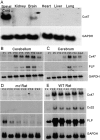

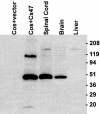

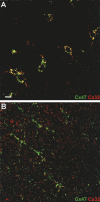
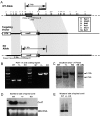
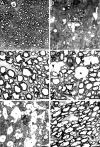
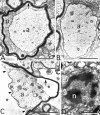
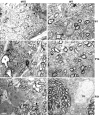
Similar articles
-
Connexin 43/47 channels are important for astrocyte/ oligodendrocyte cross-talk in myelination and demyelination.J Biosci. 2018 Dec;43(5):1055-1068. doi: 10.1007/s12038-018-9811-0. J Biosci. 2018. PMID: 30541963 Free PMC article. Review.
-
Unique distributions of the gap junction proteins connexin29, connexin32, and connexin47 in oligodendrocytes.Glia. 2004 Sep;47(4):346-57. doi: 10.1002/glia.20043. Glia. 2004. PMID: 15293232
-
Connexin 47 (Cx47)-deficient mice with enhanced green fluorescent protein reporter gene reveal predominant oligodendrocytic expression of Cx47 and display vacuolized myelin in the CNS.J Neurosci. 2003 Jun 1;23(11):4549-59. doi: 10.1523/JNEUROSCI.23-11-04549.2003. J Neurosci. 2003. PMID: 12805295 Free PMC article.
-
Connexin32 mutations cause loss of function in Schwann cells and oligodendrocytes leading to PNS and CNS myelination defects.J Neurosci. 2009 Apr 15;29(15):4736-49. doi: 10.1523/JNEUROSCI.0325-09.2009. J Neurosci. 2009. PMID: 19369543 Free PMC article.
-
Severe Convulsions and Dysmyelination in Both Jimpy and Cx32/47 -/- Mice may Associate Astrocytic L-Channel Function with Myelination and Oligodendrocytic Connexins with Internodal Kv Channels.Neurochem Res. 2017 Jun;42(6):1747-1766. doi: 10.1007/s11064-017-2194-z. Epub 2017 Feb 18. Neurochem Res. 2017. PMID: 28214987 Review.
Cited by
-
The oligodendroglial precursor cell line Oli-neu represents a cell culture system to examine functional expression of the mouse gap junction gene connexin29 (Cx29).Front Pharmacol. 2013 Jun 28;4:83. doi: 10.3389/fphar.2013.00083. Print 2013. Front Pharmacol. 2013. PMID: 23825458 Free PMC article.
-
Connexin 43/47 channels are important for astrocyte/ oligodendrocyte cross-talk in myelination and demyelination.J Biosci. 2018 Dec;43(5):1055-1068. doi: 10.1007/s12038-018-9811-0. J Biosci. 2018. PMID: 30541963 Free PMC article. Review.
-
Motor Learning and Physical Exercise in Adaptive Myelination and Remyelination.ASN Neuro. 2022 Jan-Dec;14:17590914221097510. doi: 10.1177/17590914221097510. ASN Neuro. 2022. PMID: 35635130 Free PMC article. Review.
-
Novel mutations in the GJC2 gene associated with Pelizaeus-Merzbacher-like disease.Mol Biol Rep. 2019 Aug;46(4):4507-4516. doi: 10.1007/s11033-019-04906-4. Epub 2019 Jul 3. Mol Biol Rep. 2019. PMID: 31270756
-
Astrocytes Are Required for Oligodendrocyte Survival and Maintenance of Myelin Compaction and Integrity.Front Cell Neurosci. 2020 Apr 2;14:74. doi: 10.3389/fncel.2020.00074. eCollection 2020. Front Cell Neurosci. 2020. PMID: 32300294 Free PMC article.
References
-
- Bergoffen J, Scherer SS, Wang S, Scott MO, Bone LJ, Paul DL, Chen K, Lensch MW, Chance PF, Fischbeck KH ( 1993) Connexin mutations in X-linked Charcot–Marie–Tooth disease. Science 262: 2039-2042. - PubMed
-
- Bhat RV, Axt KJ, Fosnaugh JS, Smith KJ, Johnson KA, Hill DE, Kinzler KW, Baraban JM ( 1996) Expression of the APC tumor suppressor protein in oligodendroglia. Glia 17: 169-174. - PubMed
Publication types
MeSH terms
Substances
Grants and funding
LinkOut - more resources
Full Text Sources
Other Literature Sources
Molecular Biology Databases
Miscellaneous
